An AC-DC LED Integrated Streetlight Driver with Power Factor Correction and Soft-Switching Functions
Abstract
1. Introduction
2. Description and Analysis of Operational Modes in the Proposed AC-DC LED Integrated Streetlight Driver
- (a)
- Since the switching frequencies of the two power switches S1 and S2 are much higher than the frequency of the utility line input voltage vAC, the sinusoidal utility line input voltage vAC can be considered as a constant value during each high frequency switching cycle.
- (b)
- VREC1 and VREC2 represent the input voltage sources of the input capacitors Cin1 and Cin2 after full-bridge rectification, respectively.
- (c)
- The power switches S1 and S2 operate in a complementary state, and the duty cycle of the two switches is about 0.5, taking into account the intrinsic diode and parasitic capacitance of the power switches.
- (d)
- Disregard the on-state voltage drop and its equivalent resistance for all diodes.
- (e)
- Design the LC series resonant tank circuit to operate on inductive load.
- (f)
- Design coupled inductors LB1, LB2, LB3 and LB4 to operate in discontinuous conduction mode.
- (g)
- The remaining circuit elements are considered ideal.
3. Experimental Results of the Proposed AC-DC LED Integrated Streetlight Driver
4. Conclusions
Author Contributions
Funding
Institutional Review Board Statement
Informed Consent Statement
Data Availability Statement
Acknowledgments
Conflicts of Interest
References
- Alharbi, F.; Almoshaogeh, M.I.; Ibrahim, A.H.; Haider, H.; Elmadina, A.E.M.; Alfallaj, I. Performance Appraisal of Urban Street-Lighting System: Drivers’ Opinion-Based Fuzzy Synthetic Evaluation. Appl. Sci. 2023, 13, 3333. [Google Scholar] [CrossRef]
- Ocana-Miguel, A.; Andres-Diaz, J.R.; Hermoso-Orzáez, M.J.; Gago-Calderón, A. Analysis of the Viability of Street Light Programming Using Commutation Cycles in the Power Line. Sustainability 2018, 10, 4043. [Google Scholar] [CrossRef]
- George Allwyn, R.; Al Abri, R.; Malik, A.; Al-Hinai, A. Economic Analysis of Replacing HPS Lamp with LED Lamp and Cost Estimation to Set Up PV/Battery System for Street Lighting in Oman. Energies 2021, 14, 7697. [Google Scholar] [CrossRef]
- Kerbiriou, C.; Barré, K.; Mariton, L.; Pauwels, J.; Zissis, G.; Robert, A.; Le Viol, I. Switching LPS to LED Streetlight May Dramatically Reduce Activity and Foraging of Bats. Diversity 2020, 12, 165. [Google Scholar] [CrossRef]
- Robles, J.; Zamorano, J.; Pascual, S.; Sánchez de Miguel, A.; Gallego, J.; Gaston, K.J. Evolution of Brightness and Color of the Night Sky in Madrid. Remote Sens. 2021, 13, 1511. [Google Scholar] [CrossRef]
- Adolfo, L.-M.J.; Jesús, H.-O.M.; Paulo, B. LCA Streetlight Study for Circular Economic to Local Scale. Proceedings 2020, 52, 6. [Google Scholar]
- Hamidi, S.N.A.; Omar, A.M.S.; Idin, M.A.M.; Samat, A.A.A.; Ramli, S.S.M.; Osman, M.K. Streetlight System Information Modelling and Management for Energy Reduction. In Proceedings of the 2021 6th IEEE International Conference on Recent Advances and Innovations in Engineering (ICRAIE), Kedah, Malaysia, 1–3 December 2021; pp. 1–7. [Google Scholar]
- Jayalakshmi, B.; Anjali, V.; Raj, R.N.; Nair, N.; Rahul, T.M. IoT Based Energy Efficient Automatic Streetlight. In Proceedings of the 2019 International Conference on Intelligent Computing and Control Systems (ICCS), Madurai, India, 15–17 May 2019; pp. 1478–1480. [Google Scholar]
- Marosy, G.; Kovács, Z.; Molnár, G.; Poppe, A. Diagnostics of LED-based streetlighting luminaires by means of thermal transient method. In Proceedings of the 2010 16th International Workshop on Thermal Investigations of ICs and Systems (THERMINIC), Barcelona, Spain, 6–8 October 2010; pp. 1–6. [Google Scholar]
- Lozano-Miralles, J.A.; Hermoso-Orzáez, M.J.; Gago-Calderón, A.; Brito, P. LCA Case Study to LED Outdoor Luminaries as a Circular Economy Solution to Local Scale. Sustainability 2020, 12, 190. [Google Scholar] [CrossRef]
- Novak, T.; Zeilinger, H.; Schaat, S. Increasing energy efficiency with traffic adapted intelligent streetlight management. In Proceedings of the IECON 2013–39th Annual Conference of the IEEE Industrial Electronics Society, Vienna, Austria, 10–13 November 2013; pp. 6087–6092. [Google Scholar]
- Ramli, R.M.; Arief, Y.Z.; Aziz, P.D.A. Application of LED technology into public road lighting in Malaysia for replacing the high pressure sodium vapour lighting. In Proceedings of the 2015 International Conference on Sustainable Energy Engineering and Application (ICSEEA), Bandung, Indonesia, 14–16 October 2015; pp. 76–81. [Google Scholar]
- Cheng, C.-A.; Cheng, H.-L.; Chang, C.-H.; Chang, E.-C.; Hung, W.-S.; Lai, C.-C.; Lan, L.-F. A Single-Stage High Power Factor Power Supply for Providing an LED Street-Light Lamp Featuring Soft-Switching and Bluetooth Wireless Dimming Capability. Energies 2021, 14, 477. [Google Scholar] [CrossRef]
- Hermoso-Orzáez, M.J.; Lozano-Miralles, J.A.; Lopez-Garcia, R.; Brito, P. Environmental Criteria for Assessing the Competitiveness of Public Tenders with the Replacement of Large-Scale LEDs in the Outdoor Lighting of Cities as a Key Element for Sustainable Development: Case Study Applied with PROMETHEE Methodology. Sustainability 2019, 11, 5982. [Google Scholar] [CrossRef]
- Bhairi, M.N.; Kangle, S.S.; Edake, M.S.; Madgundi, B.S.; Bhosale, V.B. Design and implementation of smart solar LED street light. In Proceedings of the 2017 International Conference on Trends in Electronics and Informatics (ICEI), Tirunelveli, India, 11–12 May 2017. [Google Scholar]
- Aoyama, Y.; Yachi, T. An LED Module Array System Designed for Streetlight Use. In Proceedings of the 2008 IEEE Energy 2030 Conference, Atlanta, GA, USA, 17–18 November 2008; pp. 1–5. [Google Scholar]
- Singh, A.; Marathey, P.; Mukhopadhyay, I. Energy positive solar LED streetlight system. In Proceedings of the 2017 International Conference on Energy, Communication, Data Analytics and Soft Computing (ICECDS), Chennai, India, 1–2 August 2017. [Google Scholar]
- Hong, S.-I.; In, C.-G.; Ryu, H.-S.; Park, J.-C.; Yoon, D.-H.; Lin, C.-H. A development of LED-IT-sensor integration streetlight management system on Ad-hoc. In Proceedings of the TENCON 2011–2011 IEEE Region 10 Conference, Bali, Indonesia, 21–24 November 2011; pp. 1331–1335. [Google Scholar]
- Jha, A.; Kumar, M. Improved Power Quality LED Driver with SELV Norms for Streetlight Application. In Proceedings of the 2018 IEEE International Conference on Power Electronics, Drives and Energy Systems (PEDES), Chennai, India, 18–21 December 2018; pp. 1–6. [Google Scholar]
- Jiang, X. Innovation to brisbane city council street lighting system with solar powered LED: A techno-economic feasibility study. In Proceedings of the 2016 Australasian Universities Power Engineering Conference (AUPEC), Brisbane, QLD, Australia, 25–28 September 2016; pp. 1–6. [Google Scholar]
- Jha, A. Smart LED Streetlighting System with Improved Power Quality and Low Standby Consumption. In Proceedings of the 2019 3rd International Conference on Recent Developments in Control, Automation & Power Engineering (RDCAPE), Noida, India, 10–11 October 2019; pp. 131–136. [Google Scholar]
- Zhang, J.; Zhu, M.; Hao, C.; Tang, J.; Yang, Q. Reliability analysis of high-power LED streetlight. In Proceedings of the 2012 9th International Conference on Fuzzy Systems and Knowledge Discovery, Chongqing, China, 29–31 May 2012; pp. 2755–2758. [Google Scholar]
- Wikipedia, the Free Encyclopedia. “Power Factor”. Available online: https://en.wikipedia.org/wiki/Power_factor#Active_PFC (accessed on 22 March 2023).
- Wikipedia, the Free Encyclopedia. “Switched-Mode Power Supply”. Available online: https://en.wikipedia.org/wiki/Switched-mode_power_supply#Types (accessed on 22 March 2023).
- Naraharisetti, K.; Green, P.B. Design of 200 W Boost PFC Plus HB LLC Resonant Converter with IR1155, IRS27952 and IR11688. Application Note, Infineon. Available online: http://www.infineon.com (accessed on 26 February 2023).
- Arias, M.; Lamar, D.G.; Linera, F.F.; Balocco, D.; Diallo, A.A.; Sebastián, J. Design of a Soft-Switching Asymmetrical Half-Bridge Converter as Second Stage of an LED Driver for Street Lighting Application. IEEE Trans. Power Electron. 2012, 27, 1608–1621. [Google Scholar] [CrossRef]
- Gao, S.; Wang, Y.; Zhang, S.; Xu, D. A two-stage quasi-resonant dual buck LED driver with digital control method. In Proceedings of the 2016 IEEE Industrial Electronics and Applications Conference (IEACon), Kota Kinabalu, Malaysia, 20–23 November 2016; pp. 36–41. [Google Scholar]
- Xie, X.; Ye, M.; Cai, Y.; Wu, J. An optocouplerless two-stage high power factor LED driver. In Proceedings of the 2011 Twenty-Sixth Annual IEEE Applied Power Electronics Conference and Exposition (APEC), Fort Worth, TX, USA, 6–11 March 2011; pp. 2078–2083. [Google Scholar]
- Athalye, P.; Harris, M.; Negley, G. A two-stage LED driver for high-performance high-voltage LED fixtures. In Proceedings of the 2012 Twenty-Seventh Annual IEEE Applied Power Electronics Conference and Exposition (APEC), Orlando, FL, USA, 5–9 February 2012; pp. 2385–2391. [Google Scholar]
- Khatua, M.; Pervaiz, S.; Afridi, K.K. Control of a Merged-Energy-Buffer based Two-Stage Electrolytic-Free Offline LED Driver. In Proceedings of the 2019 20th Workshop on Control and Modeling for Power Electronics (COMPEL), Toronto, ON, Canada, 17–20 June 2019; pp. 1–6. [Google Scholar]
- Wang, Y.; Qi, N.; Guan, Y.; Cecati, C.; Xu, D. A Single-Stage LED Driver Based on SEPIC and LLC Circuits. IEEE Trans. Ind. Electron. 2017, 64, 5766–5776. [Google Scholar] [CrossRef]
- Wang, Y.; Guan, Y.; Huang, J.; Wang, W.; Xu, D. A Single-Stage LED Driver Based on Interleaved Buck-Boost Circuit and LLC Resonant Converter. IEEE J. Emerg. Sel. Top. Power Electron. 2015, 3, 732–741. [Google Scholar] [CrossRef]
- Ma, J.; Wei, X.; Hu, L.; Zhang, J. LED Driver Based on Boost Circuit and LLC Converter. IEEE Access 2018, 6, 49588–49600. [Google Scholar] [CrossRef]
- Cheng, C.-A.; Cheng, H.-L.; Chang, C.-H.; Chang, E.-C.; Kuo, Z.-Y.; Lin, C.-K.; Hou, S.-H. A Novel AC-DC LED Integrated Streetlight Driver with Power-Factor-Correction and Soft-Switching Functions. In Proceedings of the 2021 IEEE International Future Energy Electronics Conference (IFEEC), Taipei, Taiwan, 16–19 November 2021; pp. 1–3. [Google Scholar]
- Cheng, C.-A.; Chang, C.-H.; Cheng, H.-L.; Tseng, C.-H.; Chung, T.-Y. A Single-Stage High-Power-Factor Light-Emitting Diode (LED) Driver with Coupled Inductors for Streetlight Applications. Appl. Sci. 2017, 7, 167. [Google Scholar] [CrossRef]
- Wikipedia, the Free Encyclopedia. “IEC 61000-3-2”. Available online: https://en.wikipedia.org/wiki/IEC_61000-3-2 (accessed on 26 June 2023).


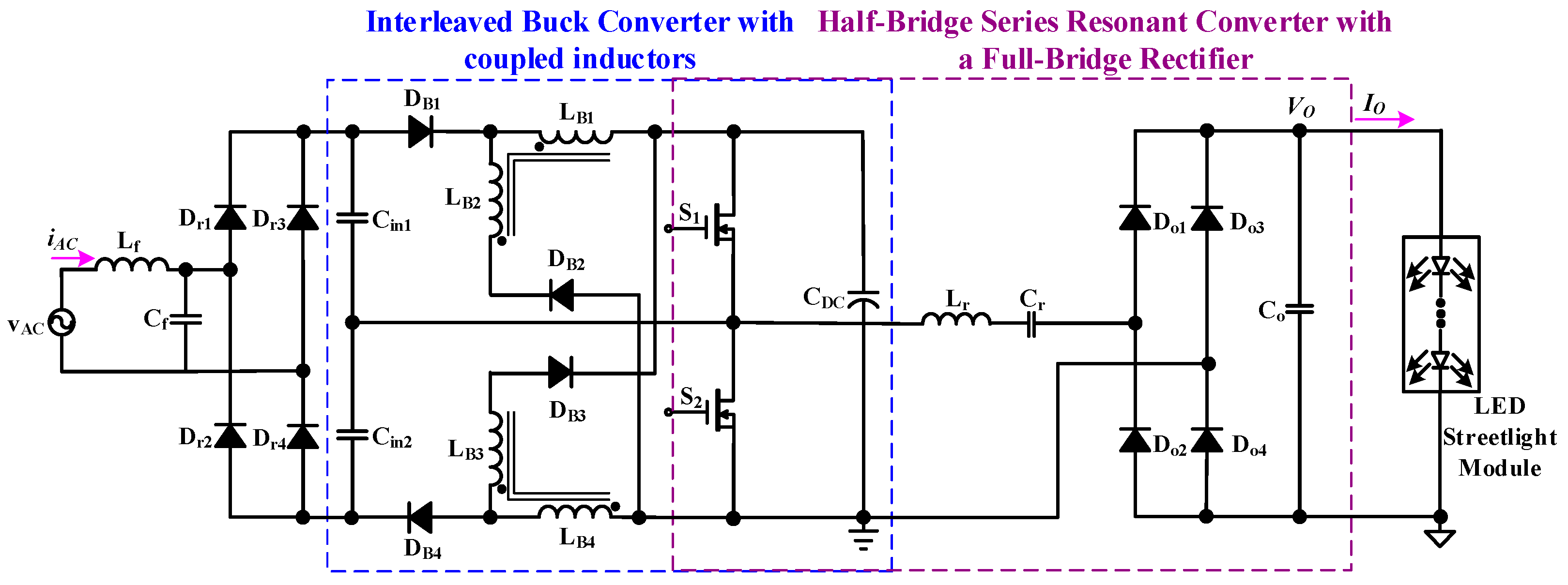

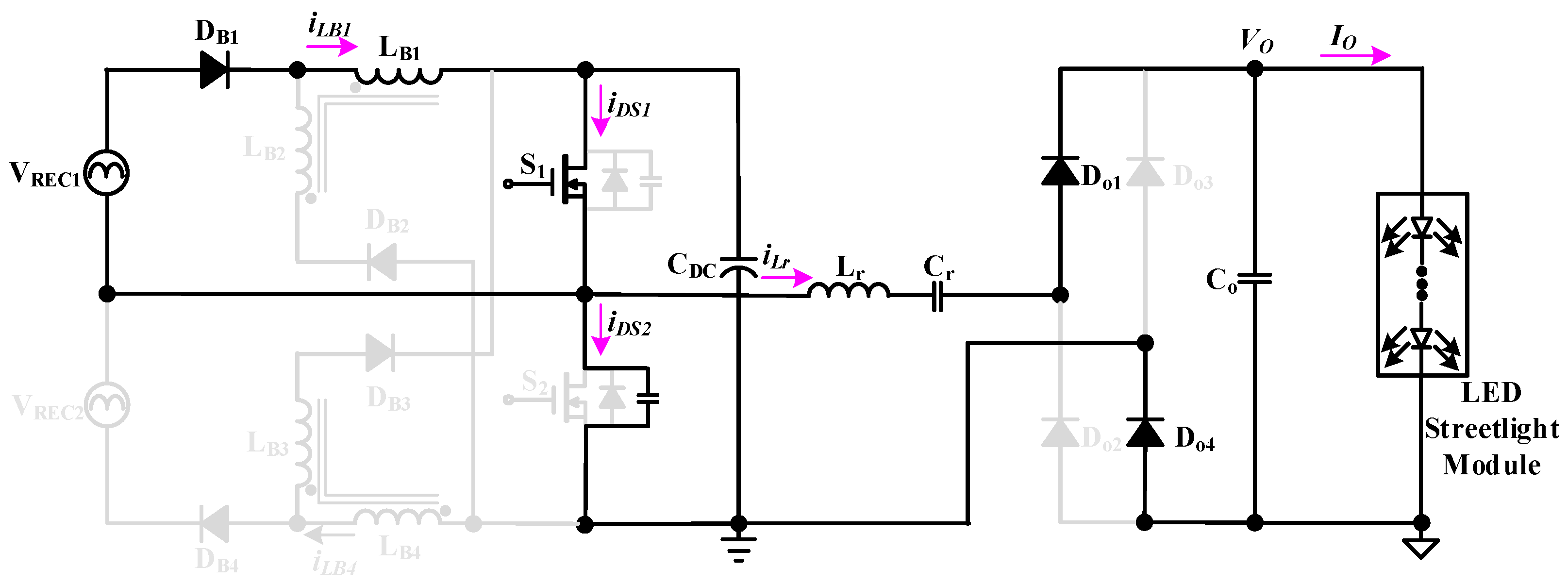
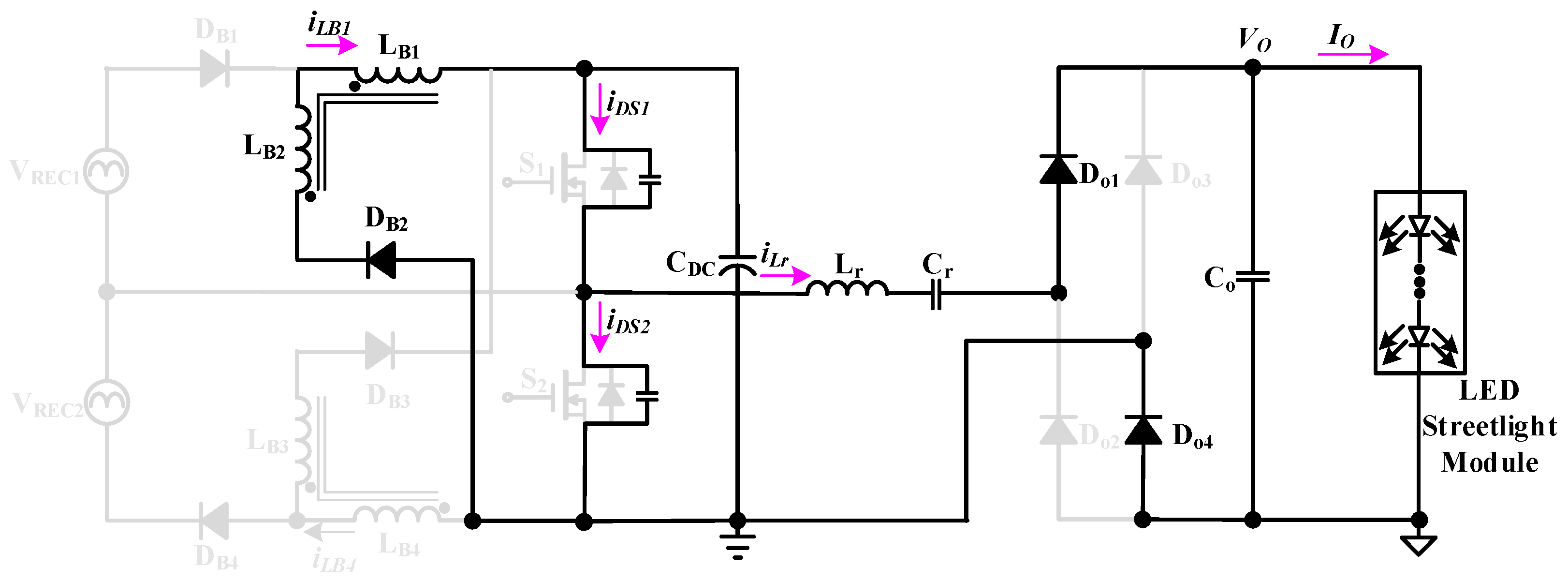

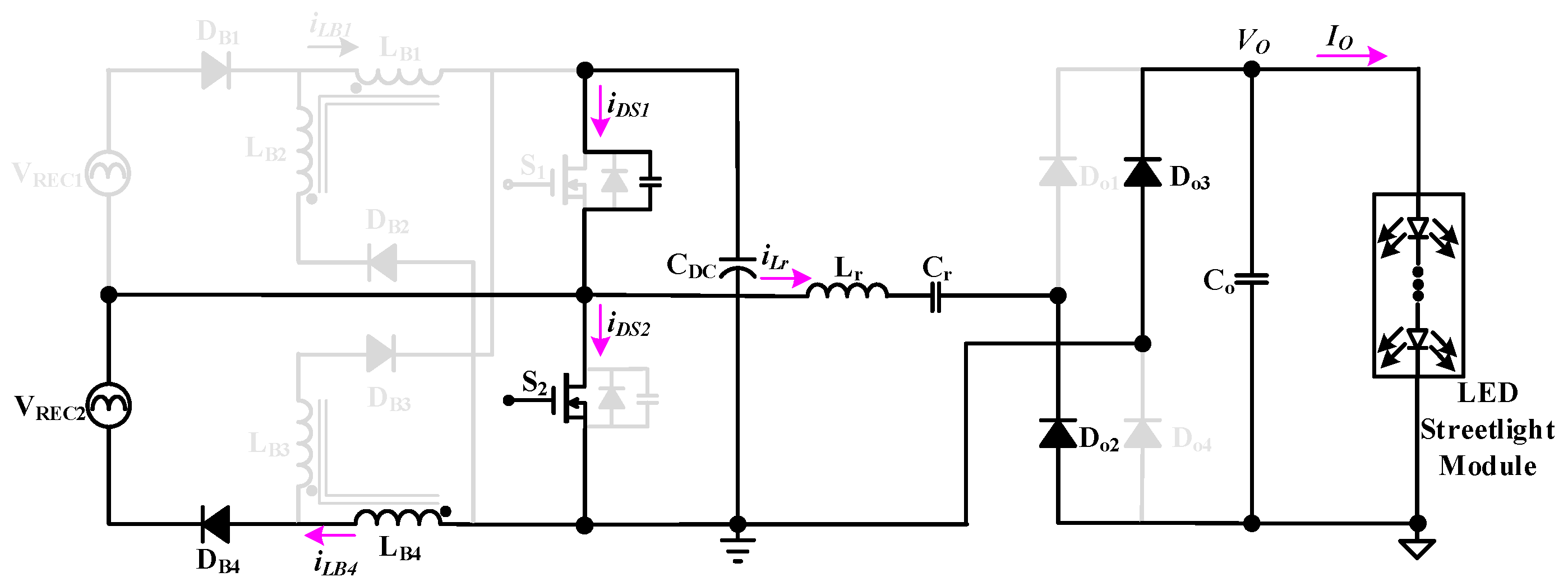

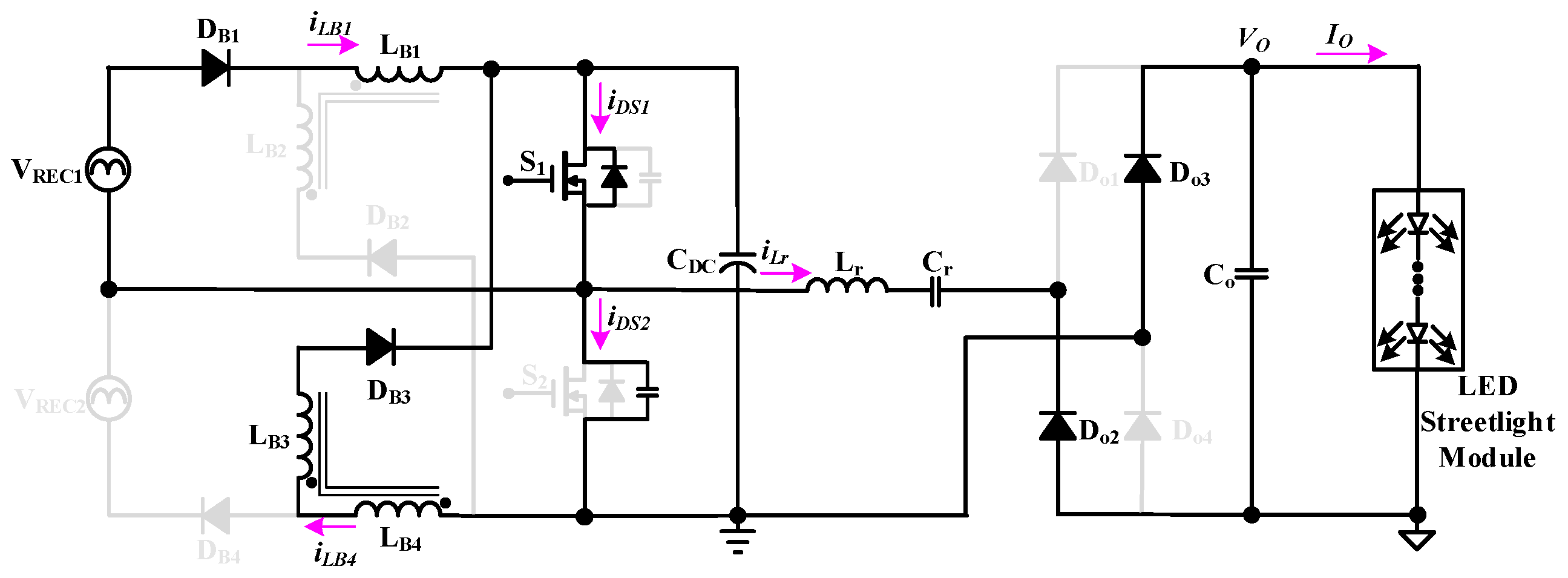
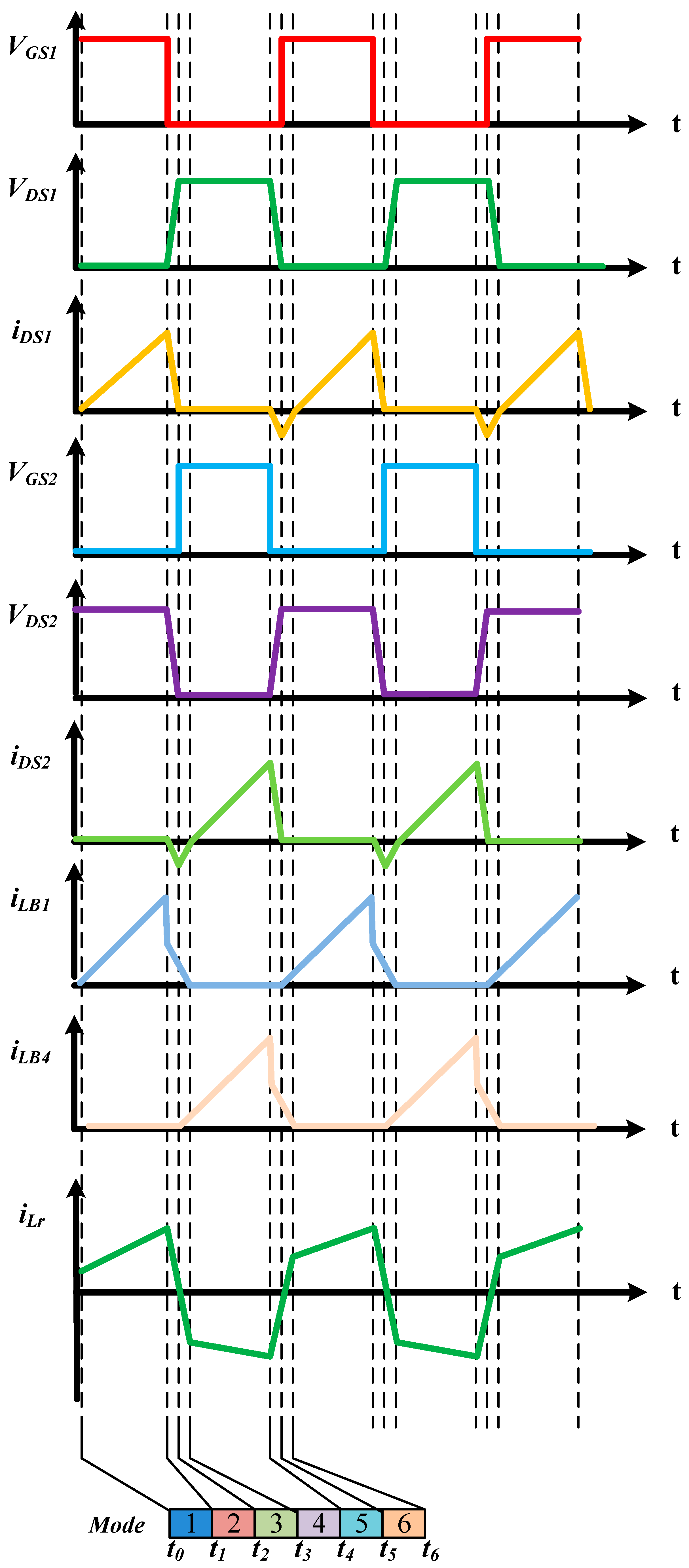
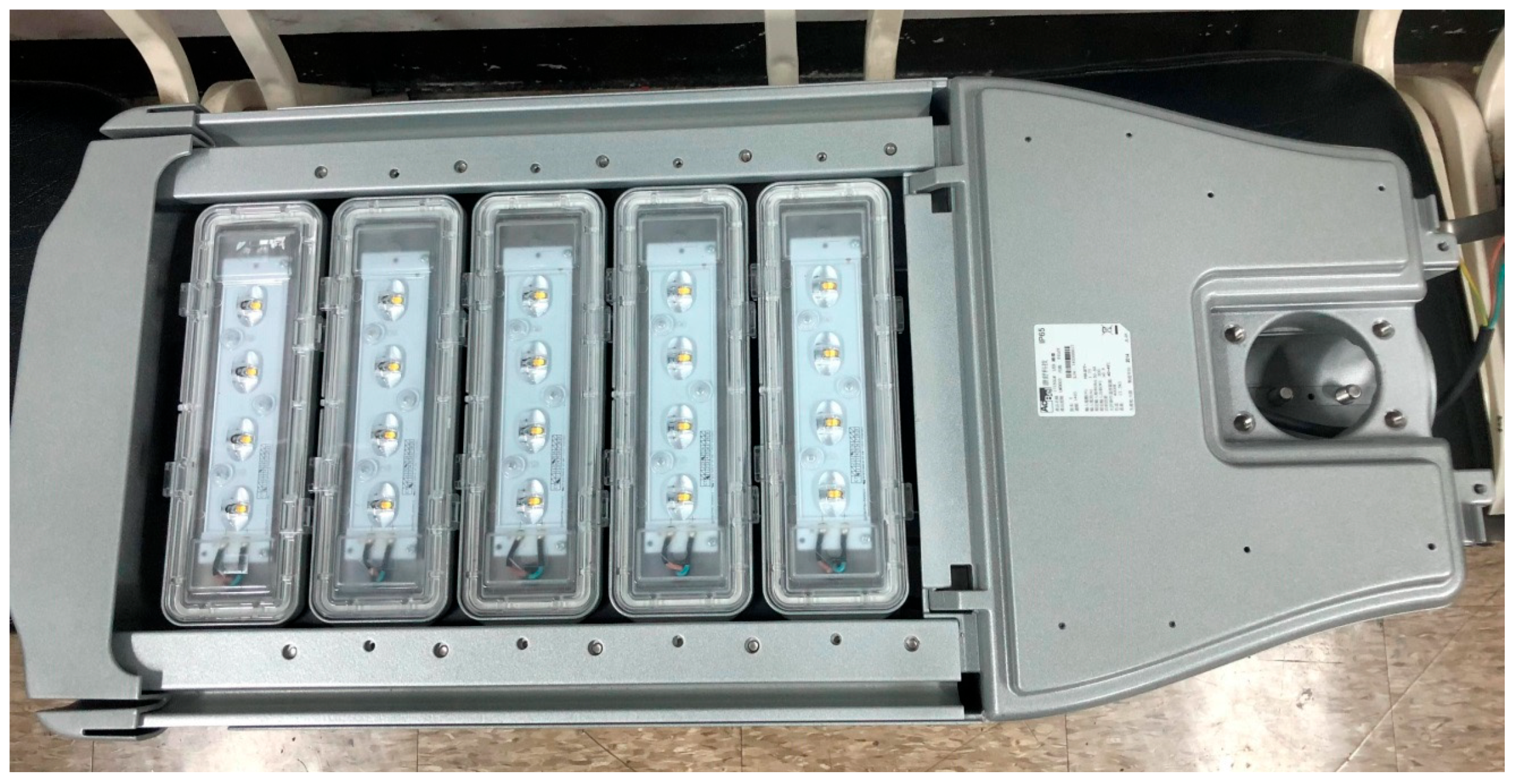

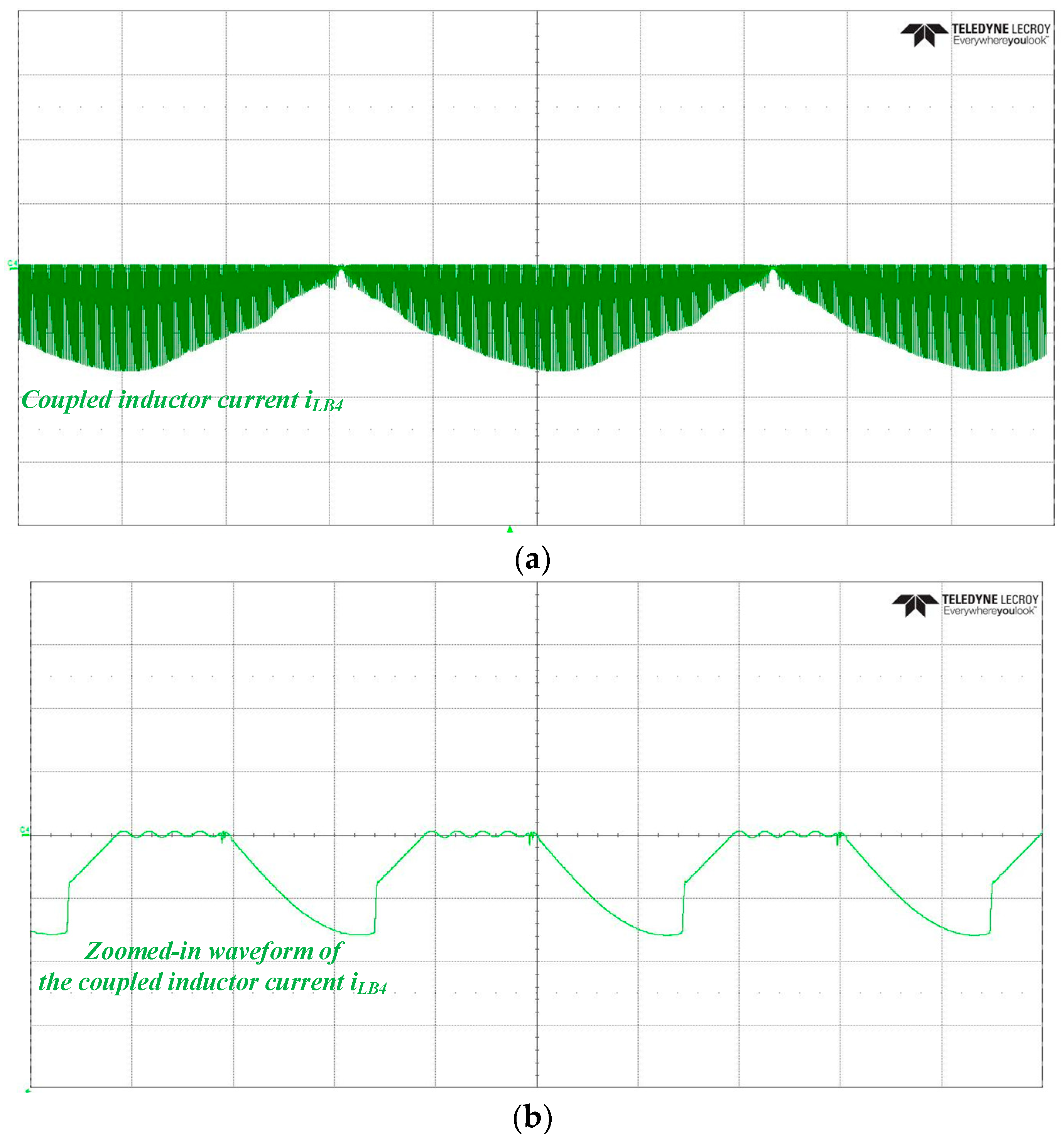



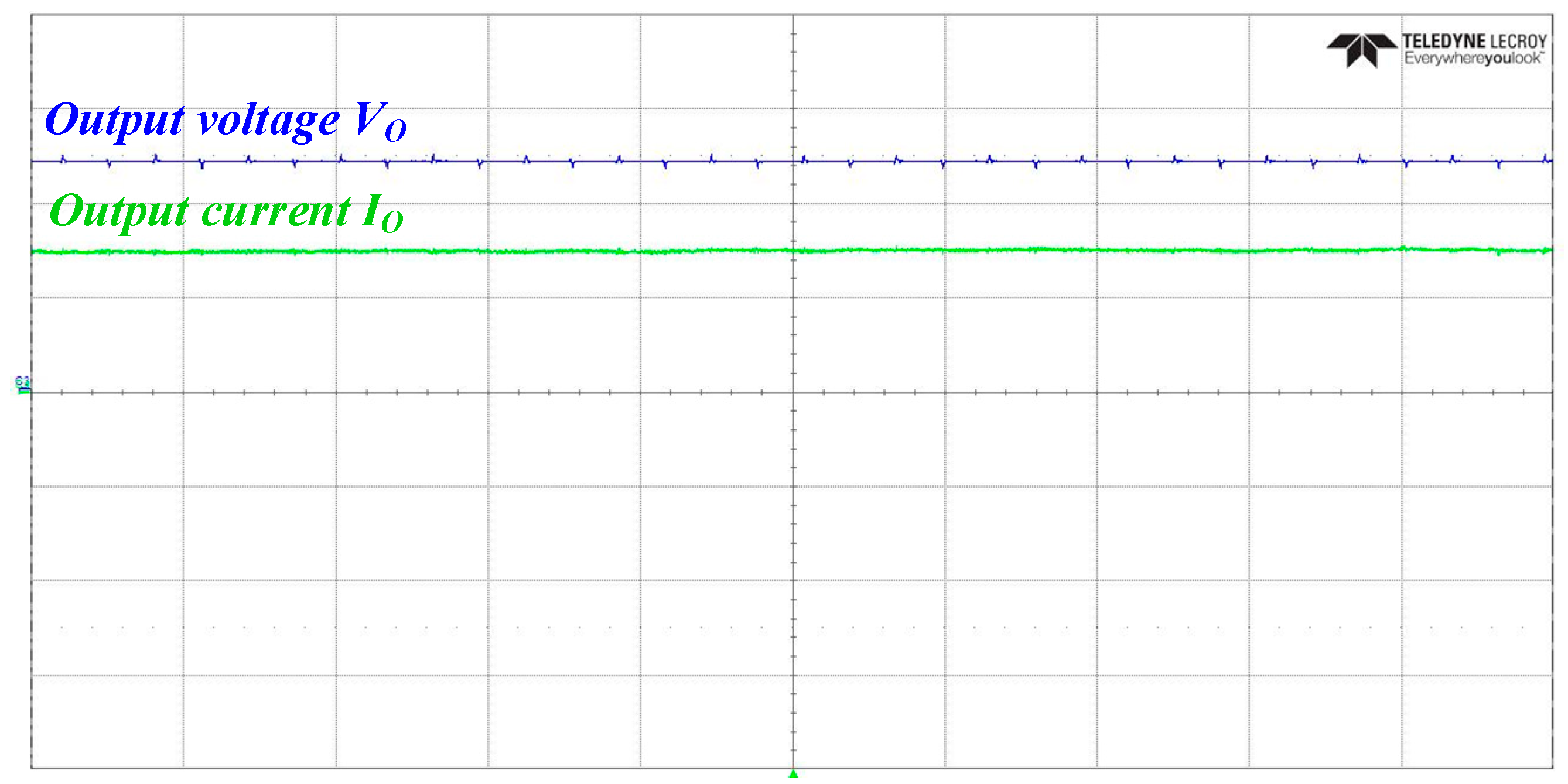
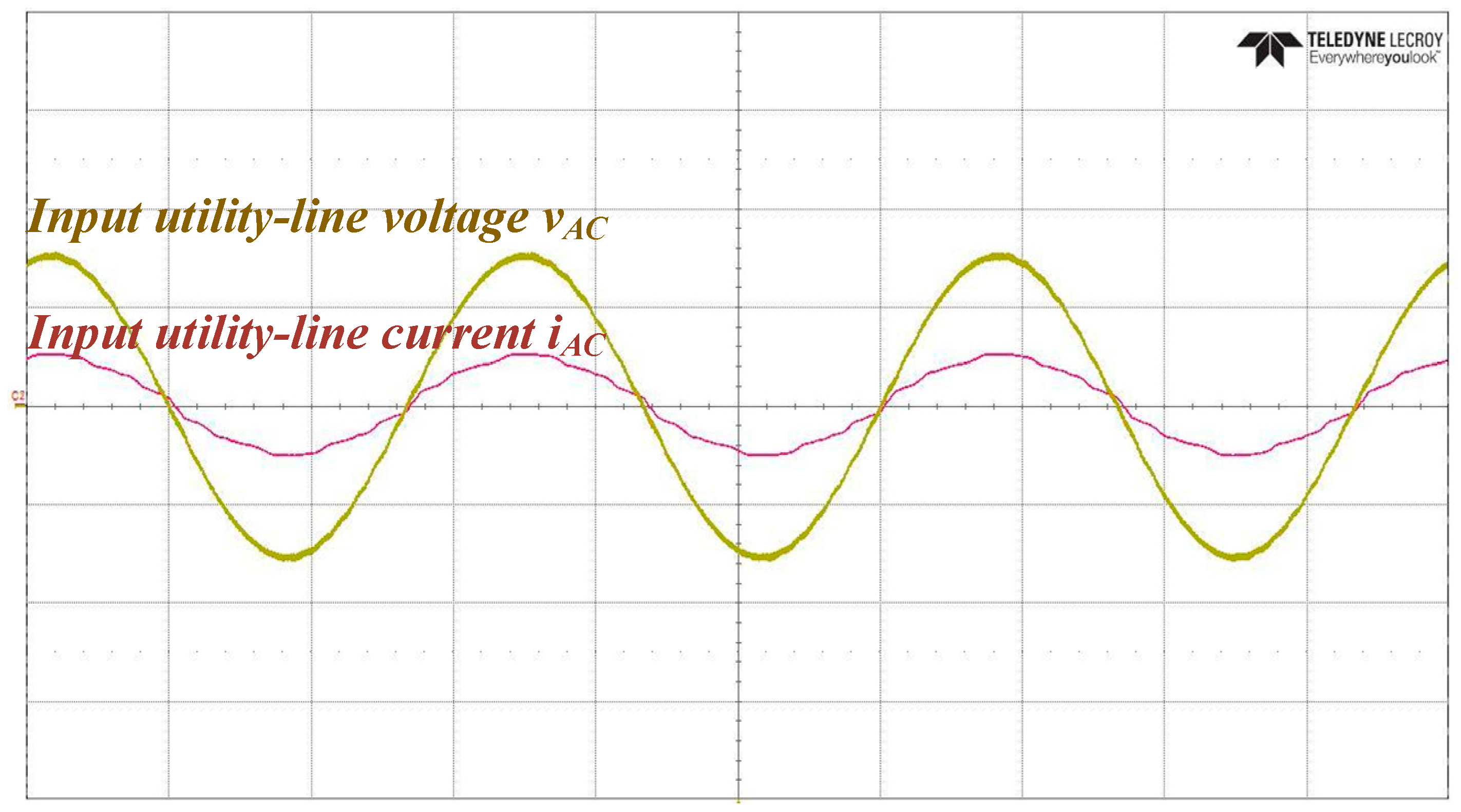
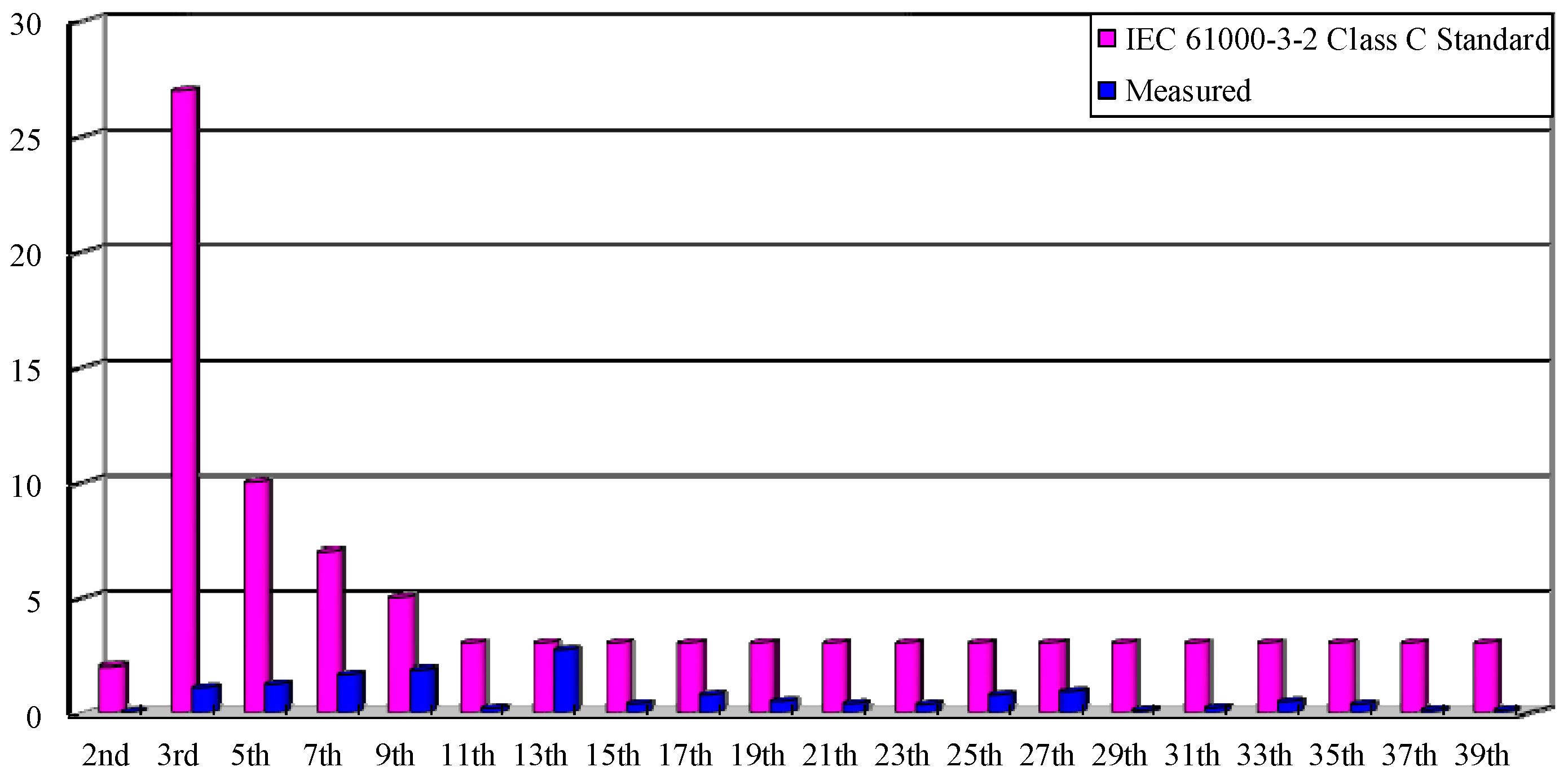
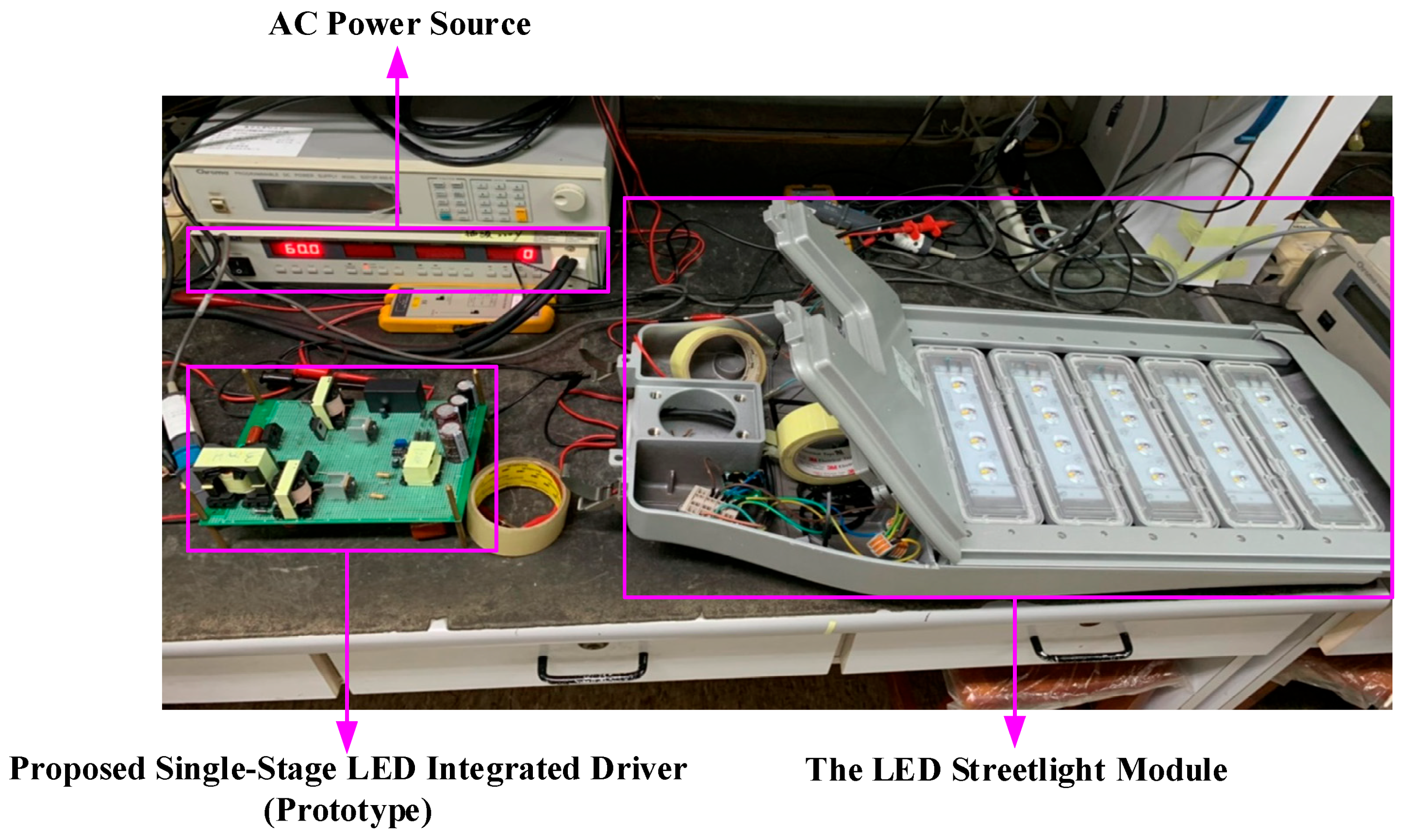
| Parameter | Value |
|---|---|
| Input Utility Line Voltage vAC | 110 V |
| Output Rated Power PO | 165 W |
| Output Rated Voltage VO | 235 V |
| Output Rated Current IO | 0.7 A |
| Component | Value |
|---|---|
| Capacitors Cin1, Cin2 | 220 nF |
| Filter Inductor Lf | 3 mH |
| Filter Capacitor Cf | 330 nF/630 V |
| Diodes Dr1, Dr2, Dr3, Dr4, | KBU 810 |
| Coupled Inductors LB1, LB4; LB2, LB3 | 170 μH; 133 μH |
| Diodes DB1, DB2, DB3, DB4, Do1, Do2, Do3, Do4 | MUR460 |
| Power Switches S1, S2 | K20J60U |
| DC-Linked Capacitor CDC | 470 μF/450 V |
| Resonant Inductor Lr | 162 μH |
| Resonant Capacitor Cr | 2 μF/250 V |
| Output Capacitor Co | 220 μF/450 V |
| Parameters | Values |
|---|---|
| Mean value of the output voltage | 235.47 V |
| Peak-to-peak value of the output voltage | 13.66 V |
| Ripple factor of the output voltage | 5.8% |
| Mean value of the output current | 703.84 mA |
| Peak-to-peak value of the output current | 45.75 mA |
| Ripple factor of the output current | 6.5% |
| Parameter | Value |
|---|---|
| Input Utility-Line Voltage vAC | 110 V |
| Circuit Efficiency | 89.92% |
| Power Factor | 0.9875 |
| Total Harmonic Distortion of Input Current | 2.3142% |
| Item | Existing AC-DC LED Integrated Streetlight Driver in Reference [35] | Proposed AC-DC LED Integrated Streetlight Driver |
|---|---|---|
| Circuit Topology | Integration of interleaved buck-boost converter with a coupled inductor and a HB-SR converter with a FB rectifier | Integration of interleaved buck converter with a coupled inductor and a HB-SR converter with a FB rectifier |
| Input Utility Line Voltage | 220 V | 110 V |
| Output Power | 165 W (235 V/0.7 A) | 165 W (235 V/0.7 A) |
| Number of Required Diodes | 12 | 12 |
| Number of Required Capacitors | 6 | 6 |
| Number of Required Magnetic Components | 4 | 4 |
| Measured Power Factor | 0.992 | 0.9875 |
| Measured Current THD | 6.55% | 2.3142% |
| Measured Circuit Efficiency | 90.22% | 89.92% |
Disclaimer/Publisher’s Note: The statements, opinions and data contained in all publications are solely those of the individual author(s) and contributor(s) and not of MDPI and/or the editor(s). MDPI and/or the editor(s) disclaim responsibility for any injury to people or property resulting from any ideas, methods, instructions or products referred to in the content. |
© 2023 by the authors. Licensee MDPI, Basel, Switzerland. This article is an open access article distributed under the terms and conditions of the Creative Commons Attribution (CC BY) license (https://creativecommons.org/licenses/by/4.0/).
Share and Cite
Cheng, C.-A.; Cheng, H.-L.; Chang, C.-H.; Chang, E.-C.; Kuo, Z.-Y.; Lin, C.-K.; Hou, S.-H. An AC-DC LED Integrated Streetlight Driver with Power Factor Correction and Soft-Switching Functions. Sustainability 2023, 15, 10579. https://doi.org/10.3390/su151310579
Cheng C-A, Cheng H-L, Chang C-H, Chang E-C, Kuo Z-Y, Lin C-K, Hou S-H. An AC-DC LED Integrated Streetlight Driver with Power Factor Correction and Soft-Switching Functions. Sustainability. 2023; 15(13):10579. https://doi.org/10.3390/su151310579
Chicago/Turabian StyleCheng, Chun-An, Hung-Liang Cheng, Chien-Hsuan Chang, En-Chih Chang, Zheng-You Kuo, Cheng-Kuan Lin, and Sheng-Hong Hou. 2023. "An AC-DC LED Integrated Streetlight Driver with Power Factor Correction and Soft-Switching Functions" Sustainability 15, no. 13: 10579. https://doi.org/10.3390/su151310579
APA StyleCheng, C.-A., Cheng, H.-L., Chang, C.-H., Chang, E.-C., Kuo, Z.-Y., Lin, C.-K., & Hou, S.-H. (2023). An AC-DC LED Integrated Streetlight Driver with Power Factor Correction and Soft-Switching Functions. Sustainability, 15(13), 10579. https://doi.org/10.3390/su151310579










